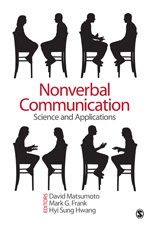
There is a growing interest in the fields of nonverbal communication and emotion recognition, specifically microexpressions.
People interested in the field of deception detection and facial expressions of emotion as well as nonverbal communication skills and are asking how do I apply these types of techniques in the real world? What types of professions is this applicable for?
Well, Psychology Today has answered that call with a review of a new book Nonverbal Communication: Science and Applications written by Humintell’s Dr. David Matsumoto and Dr. Hyi Sung Hwang as well as SUNY Buffalo’s Dr. Mark Frank.
The article goes on to write that the new book blends nonverbal communication research with how professionals have used this knowledge to excel in their profession. This includes law, negotiation, medical, marketing and many more…
It includes research chapters with ample citations that are complimented later on in the book with chapters on personal reflections of professionals that can be applied to the reader regardless of their profession.
Jeff Thompson, author of the article interviewed Dr. Matsumoto:
Q: To start things off, why did you, along with Mark Frank and Hyi Sung Hwang, write this book?
A: [DM] We created this book because there was a gap in the available books. Many are for scientists that don’t really translate how the scientific work can be translated into practice. Others are by practitioners, with sometimes little or no nod to the science, and in some cases discussing NVBs that have not been validated. We wrote this book so that scientists could appreciate the practical use of research, and practitioners could appreciate the science behind validated NVB indicators.
Q: You explain the functions of nonverbal communication as it being able to 1) define communication, 2) regulate verbal communication, and 3) be the message itself. Can you explain what these mean?
A: [DM] As stated in Chapter 1, NVC serves to provide a context for communication, sometimes commenting on words. A quick smile, for instance, when discussing the disappearance of one’s children, provides additional info that defines the communication. Our voices, faces, and head gestures regulate turn-taking in conversations. And these all occur without words sometime, and thus the NVB becomes the main message themselves.
Q: What are some common misconceptions about nonverbal communication?
A: [DM] The big misconception about NVB and deception is that averting one’s gaze or fidgeting is associated with lying. This belief is held across cultures. Studies have tested this hypothesis, and most do not support it. It is a myth.
To read more from Dr. Matsumoto’s interview click here.